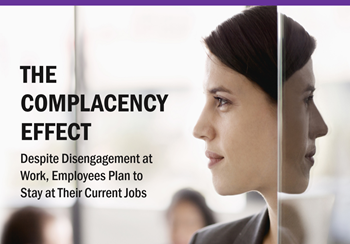Maintaining high employee engagement is key for keeping professionals motivated and productive at work, while it also contributes significantly to helping organizations retain their talent.
One obstacle that companies often face when trying to boost employee engagement is finding an accurate and practical way to measure it. Unlike many other workplace-based targets, there are few KPIs that can be tracked that truly reflect how invested professionals are in their role.
This is because it is incredibly difficult to define. To some, engagement is a measurement of happiness, while to others it's more about satisfaction within a specific role. For many businesses, employee engagement is related to how likely people are to stay with the firm. The truth is there's a wide variety of different things that make an 'engaged employee' and it can often change from one professional to the next.
To make this easier, there are a number of steps firms can take to ensure employees are engaged.
- Have a clear mission statement - Developing a mission statement that clearly conveys your goals and company culture allows you to see whether employees will be engaged with you and your business.
- Prioritize engagement in recruitment - Finding the right employees to fill your vacant roles can be a challenge but judging candidates based on how they fit into your company culture can be an effective way to ensure they will engage with you long term.
- Encourage feedback - Nurturing a culture where managers understand and listen to employees, even when they are being negative, increases the chances of professionals being engaged with your company.
However, even with these measures in place, it doesn't guarantee that you will see long-term commitment. If you're unable to monitor employee engagement, there's a significant chance that any initial loyalty towards the company can change over time or as workers’ own career priorities evolve. It's also nearly impossible to see whether measures you are taking to boost engagement are being effective. This makes finding ways of measuring engagement crucial for any businesses.
Here we break down employee engagement into six metrics, which can be effectively measured, and give a strong suggestion of whether or not professionals are committed to their role.
Recognition
Recognition doesn't necessarily mean rewarding employees either financially or otherwise but it does mean highlighting the professionals that are really excelling in their role. Research from OfficeVibe shows that 65% of employees feel that they don't get enough praise. It really is a simple change that can massively improve engagement but it needs to be implemented consistently across an organization.
Workplace Relationships
Full-time employees spend around half of their waking hours in work, so the relationships they have in the office are a great indicator for how engaged they are in their role. Studies suggest that professionals enjoying good relationships with their co-workers are happier and more productive. To encourage this kind of company culture, investing in your social budget, buddy programs, and peer-to-peer nomination schemes can be a worthwhile pursuit.
Of course, it's also important that employees have a good relationship with their managers. In order to get the most from one-to-one meetings or development progress checks, there needs to be a mutually respectful relationship between the two of them. This is something everyone at management level will need training in to ensure they can execute it appropriately. It's also essential that all managers are anonymously reviewed by their team regularly.
Feedback
To stay engaged, employees need to trust the system you have in place for registering feedback, whether that is about the company or their own performance. Ambiguity and inconsistency can lead to confusion, dissatisfaction and disengagement. There needs to be a clear system in place for managers to give employees regular feedback and for them to make their feelings about the company known.
For employees, this allows them to see the areas they need to improve in to excel in their role and know that the organization cares about how they feel in their job. Constructive feedback on both sides is a necessary part of employee engagement.
Personal Development
If employees stop wanting - or being able - to develop their own professional skills, they will become bored and start looking for other roles that challenge them. This makes giving them the support and guidance they need to evolve their expertise an essential part of ensuring employee engagement remains high.
This should be a key element of feedback meetings or one-to-ones, allowing individuals to develop their skills in the direction they want and get the assistance they need.
But how do I measure them?
Surveys are the most common way for companies to get the data they need about their employees, but it's only one piece of the engagement puzzle. Short surveys asking 3-5 questions about how they feel at work can be given to professionals at the same time every day to monitor their happiness. This can be set up to display on their computer screen every day so it becomes part of their routine and, as long as people understand why you're doing it, it should be fairly easy to implement.
For more quantitative data, regular check-ins with each individual can help to get a true understanding of how employees feel in their role. Of course, this information is only going to be accurate and valuable if professionals have a positive working relationship with their manager.
Whatever route you choose to go down, the most important element of employee engagement is reporting your findings - good and bad - back to your workforce. You can then be clear about what you're going to work on and repeat the exercise after an appropriate amount of time to establish whether the situation has changed.
Access the latest business knowledge in HR
Get Access






Comments
Join the conversation...